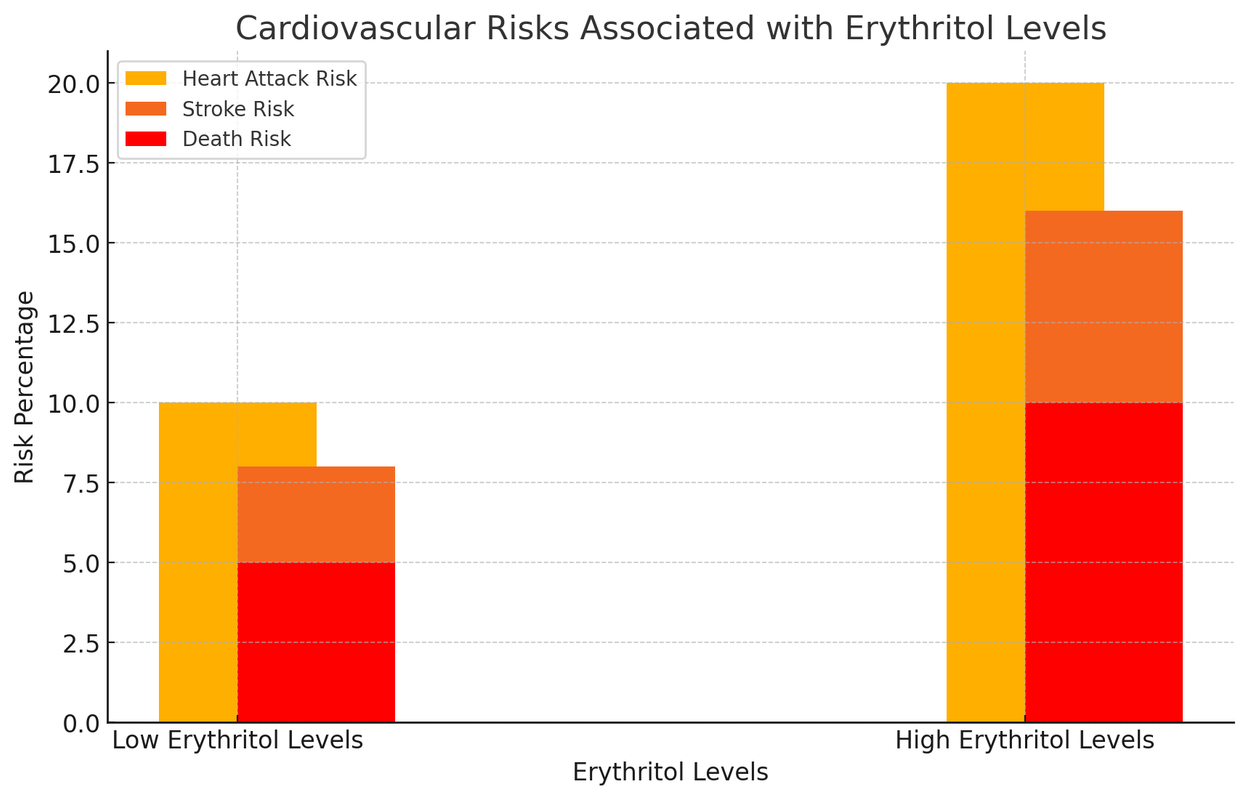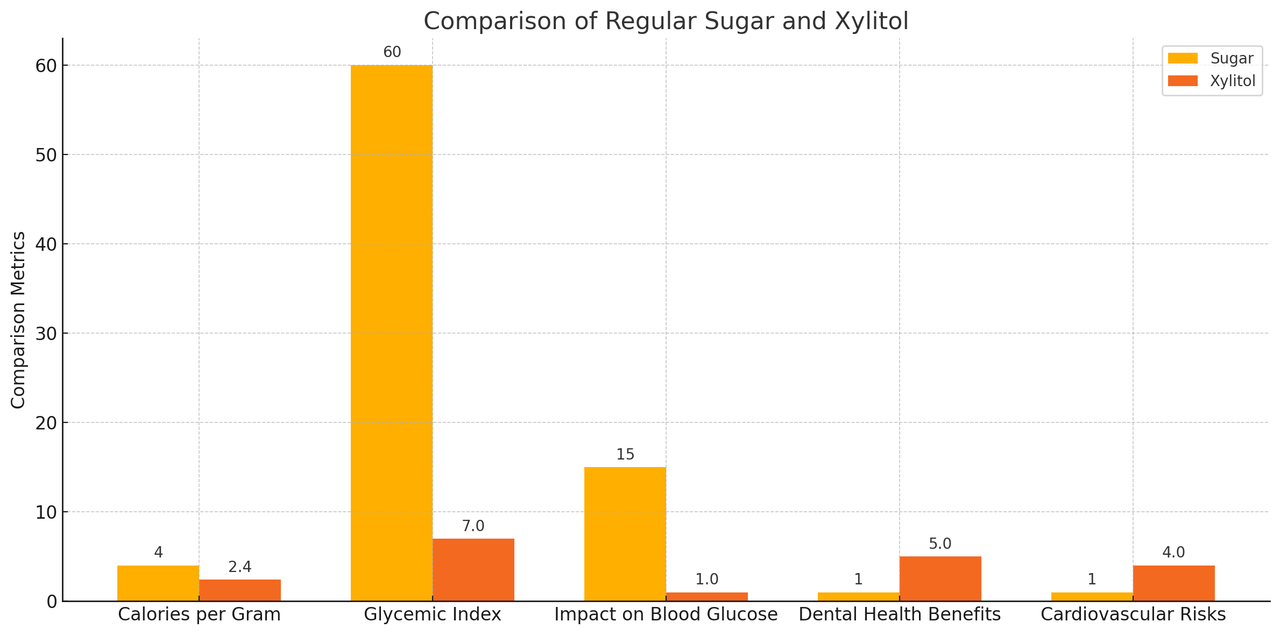
What is Xylitol ?
June 07, 2024 257Introduction
In our quest for a healthier lifestyle, many of us have turned to low-calorie sweeteners to replace sugar. However, recent studies have raised concerns about their safety. One notable study found a link between xylitol, a popular low-calorie sweetener, and an increased risk of heart attack, stroke, and death.
Recent Studies on Xylitol and Cardiovascular Risks

-
Cleveland Clinic Study on Erythritol and Xylitol: This study revealed that high levels of erythritol and xylitol in the blood are associated with an increased risk of major cardiovascular events, such as heart attacks and strokes. Researchers found that these sweeteners can enhance blood clot formation, posing a significant risk to individuals with existing health conditions like diabetes and obesity (Cleveland Clinic) (National Institutes of Health (NIH)).
-
BMJ Nutrition, Prevention & Health Study: A pilot trial published in BMJ Nutrition, Prevention & Health examined the effects of a 5-week intake of erythritol and xylitol on vascular function and metabolic health in humans. The study found that while these sweeteners could improve glycemic control and reduce visceral fat in non-diabetic rats, they also highlighted potential risks related to lipid metabolism and vascular function in humans (BMJ Nutrition).
-
NIH Research on Erythritol: An NIH-funded study led by Dr. Stanley Hazen at the Cleveland Clinic investigated the long-term cardiovascular risks associated with erythritol. This research showed that elevated erythritol levels could double the risk of cardiovascular events. The study emphasized the need for further safety evaluations of artificial sweeteners and their long-term health impacts (National Institutes of Health (NIH)).
Findings of the Study
The study revealed that people consuming high levels of xylitol had nearly twice the risk of heart attacks, strokes, and death compared to those with lower levels of consumption. This finding aligns with earlier research on erythritol, another low-calorie sweetener, showing similar risks.
What is Xylitol?
Xylitol is a sugar alcohol used as a sweetener in various food and consumer products. It’s commonly found in sugar-free gum, toothpaste, and low-calorie snacks. Chemically, xylitol combines the characteristics of sugar and alcohol, making it taste sweet without the calories of regular sugar.

The Amazing Mechanisms Behind the Risks
Xylitol is an incredible substance that has the power to alter platelet behavior, which is crucial for blood clotting. Even modest amounts of xylitol can lead to a change in platelet behavior, which can result in clots that may cause heart attacks or strokes.
Historical Context of Artificial Sweeteners
Artificial sweeteners have a long and complex history, reflecting the changing attitudes and evolving scientific understanding of their health effects. Here is a more detailed look at the key milestones in the development and use of artificial sweeteners:
Early Beginnings (19th Century)
- 1879 - Saccharin Discovery: The first artificial sweetener, saccharin, was discovered by accident in 1879 by Constantin Fahlberg, a chemist working at Johns Hopkins University. Saccharin was found to be about 300-400 times sweeter than sugar and quickly became popular during World War I and World War II when sugar shortages made it a valuable substitute.
Mid-20th Century Advances
- 1937 - Discovery of Cyclamate: Cyclamate, another artificial sweetener, was discovered in 1937 by graduate student Michael Sveda at the University of Illinois. It became popular in the 1950s and 1960s but was banned in the U.S. in 1969 after studies suggested it might cause cancer in laboratory animals.
- 1950s - Introduction of Aspartame: Aspartame was discovered in 1965 by James Schlatter, a chemist at G.D. Searle & Company. It was approved by the FDA in 1981 and became one of the most widely used artificial sweeteners, known for its use in diet sodas and many other low-calorie products.
Health Concerns and Regulatory Actions
- 1977 - Saccharin Controversy: The U.S. Congress mandated a warning label on saccharin products after studies suggested it might be linked to bladder cancer in rats. However, further research did not conclusively prove these effects in humans, and the warning labels were removed in 2000.
- 1980s - Aspartame Approval and Criticism: Despite its popularity, aspartame faced scrutiny over claims it could cause headaches, seizures, and other health issues. Numerous studies have generally supported its safety, but some critics remain wary of its long-term effects.
Modern Developments
- 1990s - Introduction of Sucralose: Discovered in 1976 and approved by the FDA in 1998, sucralose (marketed as Splenda) is about 600 times sweeter than sugar. It is heat-stable, making it suitable for baking and cooking, and quickly gained popularity.
- 2000s - Rise of Natural Sweeteners: The early 2000s saw increased interest in natural sweeteners like stevia and monk fruit. Stevia, derived from the leaves of the Stevia rebaudiana plant, was approved by the FDA in 2008 as a food additive, and monk fruit followed in 2010.
Recent Studies and Controversies
- 2010s - Erythritol and Xylitol: These sugar alcohols gained popularity in low-carb and keto diets due to their low glycemic impact. However, recent studies have raised concerns about their potential cardiovascular risks, as highlighted by the Cleveland Clinic’s research in 2023 which found links to increased heart attack and stroke risk (Cleveland Clinic) (National Institutes of Health (NIH)).
- 2023 - WHO Guidelines: The World Health Organization (WHO) published new guidelines advising against the use of non-sugar sweeteners for weight control due to potential negative health effects, including impacts on metabolic health and increased risk of cardiovascular diseases.
Interesting Facts
- Saccharin’s Accidental Discovery: Constantin Fahlberg discovered saccharin when he noticed a sweet taste on his hands after a day in the lab. He realized the compound he was working on was responsible and patented it without notifying his supervisor.
- Cyclamate's Role in Diet Sodas: Cyclamate was a key ingredient in the first diet sodas. After its ban in the U.S., other sweeteners like aspartame took its place.
- Aspartame’s Long Approval Process: Aspartame’s approval process was one of the longest for any food additive, spanning 16 years of scrutiny before gaining FDA approval in 1981.

Here is a comparative bar chart that illustrates the key differences between regular sugar and xylitol across various metrics. The chart compares their caloric content per gram, glycemic index, impact on blood glucose levels, dental health benefits, and cardiovascular risks.
- Calories per Gram: Xylitol has fewer calories than regular sugar.
- Glycemic Index: Xylitol has a much lower glycemic index, making it a better option for managing blood sugar levels.
- Impact on Blood Glucose: Regular sugar significantly raises blood glucose levels, while xylitol has a minimal impact.
- Dental Health Benefits: Xylitol offers more dental health benefits compared to regular sugar.
- Cardiovascular Risks: Recent studies indicate higher cardiovascular risks with xylitol consumption, particularly in large amounts.
This visual comparison helps to highlight the advantages and potential drawbacks of using xylitol as a sugar substitute.
How Xylitol is Listed on Labels

Xylitol can appear under various names on product labels, which can sometimes make it challenging to identify. Understanding these names and synonyms is crucial for consumers who want to manage their intake of this sweetener. Here are some common names and synonyms for xylitol:
Xylitol
The most straightforward way xylitol is listed on product labels is simply as "xylitol." This is the chemical name and is used widely across different types of products, from food items to oral care products and medications.
- Example: In a list of ingredients, you might see it written as:
- "Ingredients: Water, Xylitol, Glycerin, Natural Flavors."
Sugar Alcohol
Xylitol is part of a group of compounds known as sugar alcohols (or polyols). On some labels, especially in nutritional information sections, you might see the term "sugar alcohol" used as a broader category. While this doesn’t specify xylitol directly, it indicates the presence of one or more sugar alcohols, which could include xylitol.
- Example: On the nutrition facts label, under carbohydrates:
- "Total Carbohydrates: 25g
- Sugar Alcohol: 5g"
- "Total Carbohydrates: 25g
E967 (European Food Additive Number)
In the European Union, food additives are often listed by their E-number, which is a code for substances that are permitted to be used as food additives. Xylitol’s E-number is E967. This number might be used on labels in European products, particularly those that adhere strictly to EU labeling regulations.
- Example: On a European product, the ingredients list might include:
- "Ingredients: E967, Sorbitol, Citric Acid, Natural Flavors."
Identifying Xylitol on Different Product Labels
Food Products
When looking at food product labels, xylitol can be found in various sections. Besides the ingredient list, it may also appear in the nutritional information section, particularly if the product emphasizes being "sugar-free" or "low-calorie."
- Example: A sugar-free candy might list ingredients as:
- "Ingredients: Maltitol, Xylitol, Aspartame, Natural Flavors."
Oral Care Products
In oral care products such as toothpaste and mouthwash, xylitol is often highlighted for its dental benefits. It is usually listed in the inactive ingredients section.
- Example: A toothpaste might list:
- "Active Ingredients: Sodium Fluoride. Inactive Ingredients: Water, Xylitol, Glycerin, Hydrated Silica."
Medications and Supplements
For medications and supplements, xylitol might be used to enhance flavor, especially in chewable tablets and syrups. It is typically listed among other inactive ingredients.
- Example: A chewable vitamin label might read:
- "Other Ingredients: Xylitol, Natural Flavors, Citric Acid."
Why It’s Important to Recognize These Names
Recognizing the different names and synonyms for xylitol is crucial for several reasons:
- Health Management: For individuals with specific dietary needs, such as those managing diabetes, knowing the presence of xylitol can help maintain stable blood sugar levels.
- Avoiding Overconsumption: Excessive intake of xylitol can lead to digestive issues, so being able to identify it on labels helps in moderating consumption.
- Pet Safety: Xylitol is highly toxic to pets, especially dogs. Pet owners need to ensure that products containing xylitol are kept out of reach of their animals.
What is Xylitol For Teeth?

Xylitol is a sugar alcohol used as a sweetener, and it is particularly beneficial for dental health. Here are some key points regarding xylitol's benefits for teeth:
-
Cavity Prevention: Xylitol helps reduce the risk of dental cavities. It is not fermentable by mouth bacteria, which means it does not produce the acids that erode tooth enamel. By reducing acid production, xylitol helps protect the teeth against decay.
-
Reduction of Harmful Bacteria: Xylitol inhibits the growth of Streptococcus mutans, a primary bacterium associated with dental decay. Regular use of xylitol can decrease the overall level of harmful oral bacteria.
-
Remineralization of Teeth: Xylitol can enhance the process of remineralization, which is the repair of damaged enamel. It helps to maintain a neutral pH level in the mouth, which is conducive to remineralizing teeth, thus making them stronger.
-
Saliva Stimulation: Xylitol stimulates saliva production, which is beneficial because saliva helps to rinse away food particles and buffer acids, protecting the teeth from decay.
Products like xylitol chewing gum, mints, or toothpaste are commonly used to deliver these benefits, making them a popular choice for improving oral health. Regular use of xylitol-containing products can significantly benefit dental hygiene.
Practical Tips for Consumers
- Reduce Artificial Sweeteners: Opt for natural sweeteners like honey or maple syrup when possible.
- Read Labels Carefully: Be vigilant about ingredients in all types of products.
- Choose Whole Foods: Prioritize unprocessed foods that don’t contain added sweeteners.
Xylitol Poisoning in Dogs

Xylitol, a popular sugar substitute, is highly toxic to dogs and can cause severe health problems even in small amounts. Understanding the symptoms, causes, and treatment options for xylitol poisoning in dogs is crucial for pet owners to ensure the safety and well-being of their furry friends.
Causes of Xylitol Poisoning in Dogs
1. Common Sources of Xylitol
- Sugar-Free Gum and Candies: One of the most common sources, sugar-free gum can contain enough xylitol to be lethal to a dog.
- Baked Goods: Many "sugar-free" baked goods use xylitol as a sweetener.
- Peanut Butter: Some brands of peanut butter use xylitol, which is particularly dangerous as peanut butter is often given as a treat to dogs.
- Toothpaste and Mouthwash: Human dental care products may contain xylitol.
- Medications and Supplements: Some chewable vitamins, medications, and dietary supplements contain xylitol.
2. Accidental Ingestion
- Dogs are naturally curious and may accidentally ingest products containing xylitol if they are not stored properly. This includes accessing items from countertops, bags, or open containers.
Symptoms of Xylitol Poisoning
1. Hypoglycemia (Low Blood Sugar)
- Rapid Onset: Symptoms can appear within 10 to 60 minutes after ingestion.
- Signs: Vomiting, weakness, staggering, loss of coordination, collapse, and seizures.
2. Liver Damage
- Delayed Onset: Symptoms of liver failure can appear within a few hours to a couple of days after ingestion.
- Signs: Lethargy, jaundice (yellowing of the skin and eyes), vomiting, diarrhea, increased bruising or bleeding, and abnormal blood clotting.
3. Potential Fatality
- Severe Cases: Without prompt treatment, xylitol poisoning can be fatal due to severe hypoglycemia or liver failure.
Diagnosis of Xylitol Poisoning
1. History and Symptoms
- Veterinary Assessment: If xylitol poisoning is suspected, a veterinarian will ask about the dog’s history of exposure and observe the symptoms.
2. Blood Tests
- Hypoglycemia Detection: Blood glucose levels will be checked to diagnose hypoglycemia.
- Liver Function Tests: Blood tests to evaluate liver enzyme levels and function.
Treatment of Xylitol Poisoning
1. Immediate Veterinary Care
- Inducing Vomiting: If ingestion was recent, the veterinarian may induce vomiting to prevent further absorption of xylitol.
- Activated Charcoal: Sometimes used to bind the toxin and prevent absorption.
2. Intravenous Fluids
- Stabilizing Blood Sugar: IV fluids containing dextrose (sugar) to stabilize blood glucose levels.
- Hydration and Support: Helps maintain hydration and supports overall health during treatment.
3. Monitoring and Supportive Care
- Continuous Monitoring: Blood glucose levels and liver function will be closely monitored.
- Medications: Liver protectants and other medications may be administered as needed.
4. Long-Term Care
- Follow-Up Visits: Regular veterinary check-ups to monitor liver function and overall health after initial treatment.
Preventing Xylitol Poisoning
1. Safe Storage
- Keep Out of Reach: Store all xylitol-containing products in secure places inaccessible to pets, such as high cabinets or locked containers.
- Pet-Proof Areas: Ensure areas where such products are used or stored are pet-proof.
2. Educate Family and Visitors
- Inform Others: Make sure everyone in the household and visitors are aware of the dangers of xylitol and the importance of not leaving any products within reach of pets.
3. Use Pet-Safe Alternatives
- Pet-Friendly Products: Choose pet-friendly treats and dental care products that do not contain xylitol.
Emergency Preparedness
1. Know the Signs
- Recognize Symptoms: Be aware of the symptoms of xylitol poisoning and act quickly if they appear.
2. Veterinary Contact Information
- Keep Contacts Handy: Have the contact information of your veterinarian and the nearest emergency animal clinic readily available.
3. Quick Action
- Seek Immediate Help: If you suspect your dog has ingested xylitol, seek veterinary care immediately. Quick response can save your dog’s life.
Conclusion
Being informed about what goes into the products you use daily is crucial for maintaining your health. Xylitol offers several benefits, but it’s essential to consume it in moderation and stay aware of potential risks. By understanding how to read product labels and recognize xylitol, you can make better choices for your health and well-being.
FAQs
What are the common names for xylitol on labels?
- Xylitol, sugar alcohol, and E967.
Is xylitol safe for everyone?
- Generally, yes, but it should be consumed in moderation, and people with certain health conditions should consult their doctor.
How much xylitol is considered safe?
- Up to 50 grams per day for adults is typically considered safe, but individual tolerance may vary.
Are there natural alternatives to xylitol?
- Yes, natural sweeteners like honey, maple syrup, and stevia are good alternatives.
Can pets consume products with xylitol?
- No, xylitol is highly toxic to dogs and can cause severe health issues.

Author
ProLife Home Care